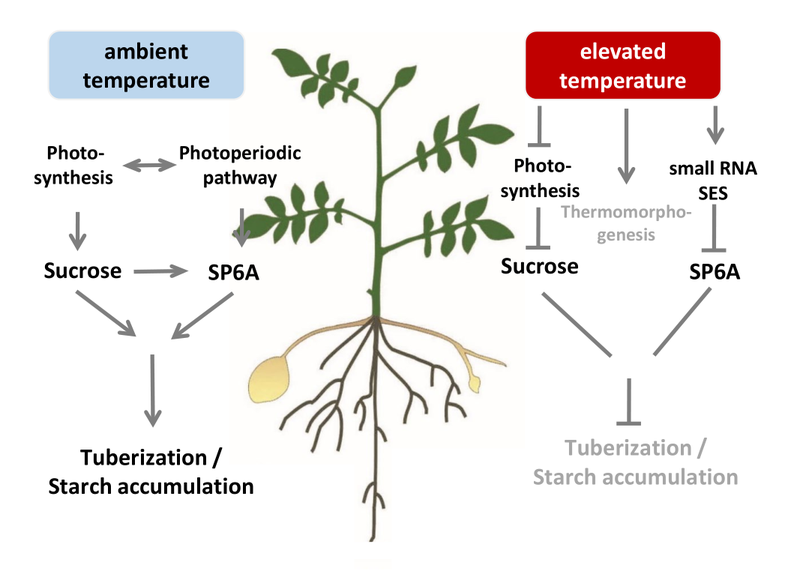Climate Adaptation of Potato – Group Sophia Sonnewald
My research group is mainly interested in the regulation of source – sink interaction during plant development and by adverse environmental conditions, such as heat & drought. We are using mainly potato plants as a model system. Potato plants are among world’s most important crops. Their tubers are an excellent staple food as they are rich in starch and contain minerals, vitamins and essential amino acids. However, potato plants are sensitive to heat and drought and global climate changes are expected to largely affect yield stability and tuber quality.
Our current research focuses on two main topics:
- Understanding responses of potato plants to heat and drought to improve them for the challenges of climate change
- Molecular analysis of potato tuber development
Improving potato plants for the future challenges of climate change
Elevated temperatures affect many physiological and developmental processes in potato plants. Among those are a reduced photosynthetic assimilate production and a strong negative effect on tuber development, starch accumulation and quality.
An important regulator of these processes is the Flowering Locus T homolog SP6A, which is a key tuberization gene. Its gene expression is reduced by heat coinciding with decreased tuber growth. In recent work, we uncovered a small RNA (termed SES) that is strongly induced by elevated temperatures and targets SP6A for post-transcriptional degradation (Lehretz et al. 2019; see Fig. 1).
- In ongoing work (DFG HotNet; https://gepris.dfg.de/gepris/projekt/432435747) we will further uncover the regulatory network acting under heat stress in potato plants by combining physiological and biochemical with molecular and genetic approaches. We exploit the genetic variability ( 2) to elucidate target genes as we think that there is a great potential to increase yield stability using the available genetic resources. Potato is a complex, highly heterozygous tetraploid crop that renders simple genetic approaches more difficult. Together with the bioinformatics group of Stephan Reinert we perform a detailed phenotyping of various tetraploid cultivars and using a GWAS approach together with transcript profiling experiments identify candidate genes.
- Within the Horizon 2020 EU funded project Adapt, we aim at a better understanding of responses of potato plants to combined stresses in particular to heat, drought and waterlogging. Apapt is a research consortium of 17 partners from leading academic research institutions, potato breeders, a non-profit EU association, a government agency and a plant phenotyping and imaging technology developer. The objectives are to identify new breeding targets and potato varieties that allow adaptation to changing environmental growth conditions in the future. Amongst others, we will further analyse the role of SP6A and the small regulatory RNA SES. For more information and updates visit the official project’s website (adapt.univie.ac.at) and Twitter account (@eu_Adapt).
- Changing environmental conditions also lead to reduced tuber starch content and may cause second tuber growth (Fig. 2b, c). Both traits result in loss of tuber quality and hamper their usage. Therefore, my group seeks after elucidating the underlying molecular mechanisms.
Molecular analysis of potato tuber development
- Potato tuber development strongly depends on metabolic and developmental signals from the leaves. Thus, the photoperiodic pathway with Constans / SP6A as key regulators has a strong control over tuber formation and growth. Recent work uncovered that SP6A interacts with sucrose efflux transporter(s) such as Sweet11b and may thereby promote assimilate translocation towards developing tubers. Even though our knowledge increased recently, there are still many open questions about the mode of action and the endogenous and environmental regulators.


